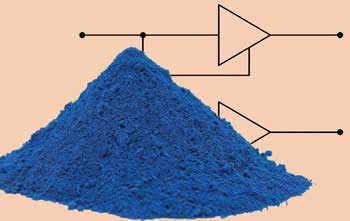| Posted: November 10, 2006 |
Paint me a nanocomposite computer |
|
(Nanowerk News) Konrad Szacilowski and colleagues at the Jagiellonian University in Krakow/Poland have made chemical switches out of titanium dioxide and Prussian blue, which are both commonly used paint pigments. The switches can replicate the basic logical operations in digital circuits. In addition, their behaviour can be altered by shining light on them, allowing direct input of signals from optical fibres.
The findings were published in an article in Journal of Materials Chemistry ("Synthesis, structure and photoelectrochemical properties of the TiO2–Prussian blue nanocomposite")
|
 |
| Prussian blue is a commonly used paint pigment (Image: RSC)
|
|
A P de Silva of Queens University Belfast, UK, said that the research ‘will strengthen the worldwide effort in computation with molecular and nanostructured systems’.
|
|
Szacilowski contrasts their composite material with other molecule-based logic gates: ‘The information channels transmit easily tunable electrical and optical signals instead of, for example, concentration or pH.’
|
|
Francisco Raymo, an assistant professor at the University of Miami, Florida, US, said that it is ‘an important addition to the emerging field of molecular logic gates’, but warned that ‘the switching speeds and stabilities of these systems, as well as the inherent challenge in interconnecting independent logic gates based on this protocol, might complicate the application of these materials at the present stage of their development.’
|
|
‘At this point our devices cannot compete with classical, semiconductor-based processors, in terms of computational power, efficiency and user-friendliness,’ admitted Szacilowski. But he suggests that the combination of chemistry with information processing may lead to greater insight into molecular processes at work in the brains and nervous systems of animals.
|

